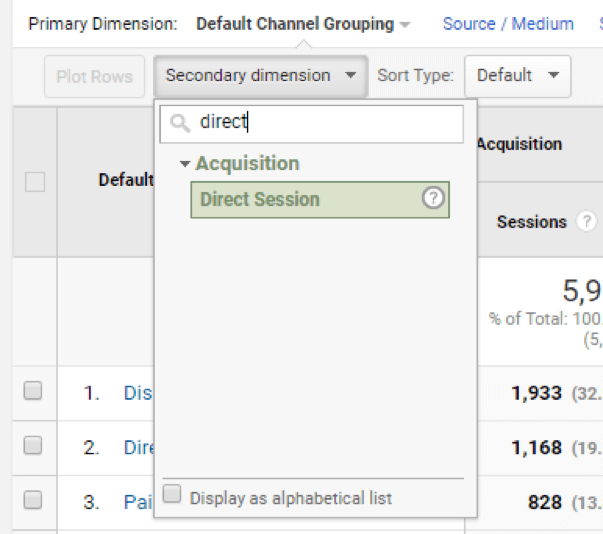Enhance Your Information Analysis Utilizing Second Dimension in Google Analytics
Checking out the capacities of additional measurements in Google Analytics opens up a world of opportunities for refining data analysis. The capacity to dissect info further past the surface area degree provides a nuanced view that can form tactical choices. By layering additional dimensions onto main information sets, a more intricate narrative arises, clarifying user interactions and efficiency signs. This vibrant strategy to data exam holds the essential to opening concealed patterns and patterns that could transform just how services translate their digital impact.
Recognizing Second Measurements
Additional dimensions in Google Analytics refer to additional criteria that can be included to the key measurement, allowing for a more detailed evaluation of data (Secondary Dimension in Google Analytics). By integrating second measurements, analysts can segment and filter information to uncover patterns, fads, and relationships that may not be noticeable when looking at the information as a whole.

Advantages of Using Additional Measurements
When evaluating information in Google Analytics, the application of additional dimensions provides very useful insights into customer habits and performance metrics. By adding a second dimension to your key information, you can delve much deeper right into the attributes of your website site visitors and their communications.
Furthermore, additional dimensions aid in determining patterns and connections that may not be promptly noticeable when looking at the information in isolation. This much deeper level of analysis can discover important info that can direct advertising approaches, web site optimization, and total organization choices. Additionally, second dimensions enhance the context of your key data, offering a more extensive view of customer engagement and efficiency metrics. In general, making use of second dimensions in Google Analytics can dramatically boost the depth and quality of your data evaluation, bring about even more educated decision-making and enhanced results.
Exactly How to Add Additional Dimensions
By including additional dimensions in Google Analytics, individuals can obtain much deeper understandings right into their information evaluation process, enabling more thorough evaluation of individual habits and performance metrics. Including second dimensions is a simple process that can dramatically improve the depth of analysis. To add a secondary measurement in Google Analytics, beginning by navigating to the record you intend to assess. Once in the report, find the "Secondary measurement" tab over the data table. Click on it to disclose a dropdown menu with different choices such as Behavior, Modern Technology, and Custom-made Capacities. Select the dimension you wish to add, such as 'Source/Medium' or 'Tool Classification'. This additional measurement will certainly then be used to your existing information, providing added context and permitting a more comprehensive evaluation of individual communications. By utilizing second measurements properly, customers can uncover important insights that might have or else been neglected, Bonuses causing notified decision-making and enhanced efficiency methods.
Analyzing Data With Second Dimensions
Making use of additional dimensions in information analysis supplies a much more comprehensive understanding of customer actions and performance metrics. By including a secondary measurement to your primary information set in Google Analytics, you can delve much deeper right into the features of your web site visitors and their interactions. Combining the primary measurement of 'source/medium' with the second dimension of 'touchdown web page' can reveal which details pages are drawing in website traffic from different resources, aiding you optimize these pages for far better interaction.
Basically, evaluating data with additional measurements encourages you to obtain valuable insights right into customer actions, determine trends, and make informed decisions to enhance the efficiency of your digital residential properties.
Finest Practices for Secondary Dimensions
In data evaluation, integrating additional dimensions efficiently can substantially enhance the depth of insights stemmed from metrics and user behavior patterns. When using second measurements in Google Analytics or any kind of other analytical device, it is vital to stick to ideal methods to ensure the precision and significance of the data analysis.
One key ideal method is to very carefully choose additional measurements that complement the main measurement being examined. Selecting important site second dimensions that offer added context or further segmentation can use a much more detailed understanding of the data. It is likewise necessary to avoid overcomplicating the evaluation by including way too many additional dimensions, which might result in complication or dilution of insights.
Moreover, it is suggested to experiment with different combinations of key and secondary measurements to discover new correlations and fads. On a regular basis examining and refining the choice of second dimensions based on the details goals of the evaluation can lead to more workable understandings. By complying with these finest practices, data experts can utilize secondary measurements successfully to enhance the total data evaluation procedure and decision-making abilities.

Conclusion
Finally, integrating second measurements in Google Analytics is vital for a thorough information evaluation technique. By leveraging second dimensions together with key ones, analysts and online marketers can discover useful understandings and relationships that can educate decision-making and maximize electronic advertising approaches. Recognizing how to effectively make use of additional dimensions and adhering to best practices will enable professionals to extract purposeful data and boost their general performance metrics.
Secondary measurements in Google Analytics refer to additional parameters that can be included to the main measurement, enabling for a more comprehensive analysis of data. By integrating secondary measurements, analysts can section and filter information check to reveal patterns, fads, and correlations that could not be apparent when looking at the data as a whole. Combining the key measurement of 'source/medium' with the second dimension of 'touchdown web page' can reveal which particular pages are attracting traffic from different sources, aiding you optimize these web pages for much better involvement.
One trick best method is to carefully choose secondary dimensions that enhance the main dimension being analyzed. By adhering to these ideal methods, information experts can take advantage of secondary dimensions effectively to enhance the general data analysis procedure and decision-making capacities.